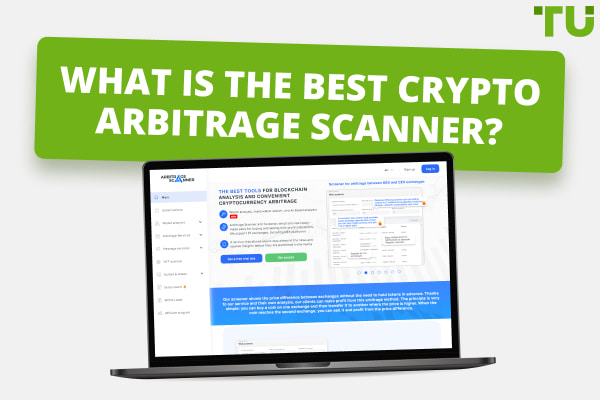Best crypto staking platforms in 2024
We have made a list of the best cryptocurrency exchanges for your crypto staking. The exchanges on this list allow users to utilize their cryptocurrencies to earn rewards and have undergone a thorough evaluation by us. The rewards programs for each platform are described in detail below, but before we proceed to the list, let's have a quick understanding of what crypto staking is, so that brings us to our first question.
Start trading crypto now with ByBit!What is crypto staking?
Crypto staking is the practice of "locking up" your digital tokens for a set amount of time in order to improve the functionality and security of the corresponding blockchain network. In exchange, you will have the chance to make money by staking your tokens. Usually, investors have an interest reward (3-30% per year). That's why crypto enthusiasts consider staking is an excellent passive type of investment.
What is a crypto-staking APY?
The term "annual percentage yield" for cryptocurrency staking refers to the compounded yearly staking return expressed as a percentage. An annual percentage yield is more prevalent in the cryptocurrency world than an annual percentage rate, and it includes the fact that over time, you also receive interest on your interest payments.
What coins can I stake?
Staking isn't an option with all types of cryptocurrencies. It's only available with cryptocurrencies that use the proof-of-stake model. So, you need a cryptocurrency that validates transactions with proof of stake. Start by learning more about any proof-of-stake cryptos that catch your eye, including how they work, their staking rewards, and the staking process with each one.
Top 5 crypto staking platforms
In our search for the best crypto-staking platforms in 2023, we focused on a specific set of criteria. From an investment perspective, this covered metrics such as the yields on offer, lock-up terms, and the number of supported tokens.
In terms of security, we explored whether each platform holds a regulatory license and what systems are in place to ensure your crypto-staking endeavors are conducted in a safe environment. We also looked at the customer service options.
The findings of our crypto-staking platform can be found below:
ByBit
Binance
Currency.com
Coinbase
Crypto.com
ByBit
If you fear fixed-term staking, ByBit offers additional flexible staking to ease your concerns. Besides, the ample choice of top coins makes it a perfect staking destination.
ByBit savings support staking in BTC, ETH, USDT, Bit, SOL, DOT, and so on. What’s missing is compound staking, and you will have to reinvest manually for continuous earnings.
Regardless, ByBit staking is one of the most flexible offerings in the crypto space with industry-leading APYs that you shouldn’t miss.
ByBit Staking Guide - Supported Tokens and RewardsBinance
One of the top cryptocurrency staking sites for people seeking large returns is Binance. The almost 100 different staking coins that can be supported by this well-known exchange platform span a wide spectrum of projects and APYs. Additionally, Binance provides a range of options for the length of time you want to lock up your tokens. Normally, this covers a time frame of 10, 30, 60, or 90 days.
Binance Staking Guide | All Supported Tokens and RewardsCoinbase
Coinbase is perhaps the best crypto staking platform to consider if you are a beginner who is also looking to buy and sell digital assets in a secure environment. This is because, in addition to staking services, Coinbase offers a regulated and user-friendly exchange platform. As of this writing, Coinbase supports six digital currencies that can be staked. This is inclusive of Ethereum, Algorand, Cosmos, Tezos, Dai, and USDC. Rates on offer vary from 0.15% APY on USDC to 5% on Cosmos.
Crypto.com
Crypto.com, one of the top cryptocurrency staking sites, enables users to profit from holding stablecoins for an annual return of up to 14%. At Crypto.com, there are daily rewards, weekly incentives, and monthly rewards available for staking. Users also have the option of individually or collectively staking their currencies.
The platform's user-friendly design makes it simple for you to manage your stake rewards. They offer a mobile app so you can manage your investments while you're on the road. With just a few touches, you can establish a staking time that can be flexible or long-term.
Kraken
According to CoinMarketCap, Kraken is the fourth largest crypto exchange. In addition to allowing staking in 12 crypto assets, Kraken also supports unstaking for most crypto assets.
When you unstake, you are taking your staked money out so that you can trade or withdraw it. As a result, there is no bonding period in practice.
Also, Kraken gives you staking rewards once or twice a week depending on the coin you stake. As you earn rewards, you can stake them further to maximize your earnings.
Kraken refers to this method as on-chain staking. In select countries, they also offer off-chain staking. As a final note, Kraken does not charge a fee for staking or un-staking.
Kraken Fees ReviewWhere to stake crypto with the highest APY
Your needs as an investor will determine the best crypto investment platform that allows you to earn interest. You should consider which cryptocurrency you'll earn interest on, so you can compare rates.
Let's compare the different APYs you can earn when staking, depending on the type of coin and platform. Check out the table below:
| Binance | ByBit | Huobi Global | OKEx | Crypto.com | |
|---|---|---|---|---|---|
Tether (USDT) |
10.00% |
4.25% |
Up to 20% APY |
10.00% |
6.5% |
USD COIN (USDC) |
N/A |
5.50% |
Up to 20% APY |
12.00% |
6.5% |
Ethereum 2.0 (ETH) |
5.20% |
1.75% |
Up to 20% APY |
4.07% |
4% |
Binance Coin (BNB) |
10.00% |
N/A |
Up to 20% APY |
N/A |
3% |
Solana (SOL) |
1.50% - 14.79% |
0.58% |
Up to 20% APY |
12% |
4.5% |
Cardano (ADA) |
2.00% - 15.79% |
0.55% |
Up to 20% APY |
5% |
3% |
Cosmos (ATOM) |
1.42% - 30.49% |
1.10% |
Up to 20% APY |
N/A |
5% |
Tezos (XTZ) |
2.00% - 8.67% |
N/A |
Up to 20% APY |
N/A |
N/A |
Polkadot (DOT) |
3.00% - 20.98% |
1.32% |
Up to 20% APY |
N/A |
12.5% |
Algorand (ALGO) |
1.00% - 8.24% |
5% - 10% |
Up to 20% APY |
N/A |
3% |
|
|
|
|
|
|
Is crypto staking a good idea?
Yes, it is!
Earning interest on your cryptocurrency investments is an excellent way to grow your income. If you need to withdraw your cryptocurrency holdings, many platforms allow you to do so at any time.
However, there are some companies that require you to keep your crypto in your savings account for a minimum period of time. In this case, you are more exposed to cryptocurrency price volatility. A falling cryptocurrency's value would make your investment worth less even though you'd earn interest.
What is the minimum staking period?
The minimum staking period is the minimum amount of time an account needs to be staked to a consensus node before the account is eligible to earn rewards. The minimum staking period is one day, which is 24 hours.
How to stake crypto
Here’s a step-by-step guide on how you can begin crypto staking.
Step 1
Make a decision about which cryptocurrency exchange to use. Choose a reputable, well-known exchange with a large currency selection.
Step 2
Sign up for an account with a cryptocurrency exchange. In order to complete the registration process, you will need to provide your personal information and verify your identity.
Step 3
Make a deposit into your account using fiat money.
Step 4
Select a cryptocurrency that you are interested in buying and staking. The number of cryptocurrencies you invest in is up to you. Make sure you research your options before making a decision.
Step 5
Buy your chosen cryptocurrency. To submit and complete a buy order for cryptocurrencies, follow the steps provided by the exchange.
Step 6
Join the exchange’s staking pool. While staking can work differently depending on the cryptocurrency, most use staking pools. Crypto traders combine their funds in these staking pools to have a better chance of earning staking rewards. Research the staking pools available for the cryptocurrency you have.
Best coins to stake in 2024
Here are a few of the major cryptocurrencies you can stake and a little bit about each one:
1. Tether (USDT)
Tether is one of the top coins to stake in 2022, with yields being as high as 12.3%. Tether ranks as the biggest stablecoin based on market cap.
As a stablecoin, Tether creates tokens when they deposit funds into their reserves and burn the equivalent amounts as funds are extracted or withdrawn. As a result, fewer coins will be in circulation, which means demand and price increase. This means you can earn more when staking coins like Tether.
2. USD COIN (USDC)
USD COIN is a digital currency backed by U.S. dollars. The currency allows people to send, spend, and exchange money around the globe quickly and safely.
Staking USD COIN comes with lower risk because it’s backed by an outside asset—typically, USD. Like other digital assets, USD COIN has a burning mechanism. The coin is “burned” whenever someone sells it for fiat currency (USD).
3. Ethereum 2.0 (ETH)
Investors can earn passive income by staking Ethereum 2.0 (ETH). To stake with this coin, you’ll need to own at least 32 ETH. The platform has now moved to a proof-of-stake model, which validates transactions using nodes run by stakers. Currently, more than $12 billion in ETH has been staked so far. Stakers of ETH could receive a maximum annual reward rate of 18.10%.
Ethereum Price Prediction 2022, 2025, 20304. Binance Coin (BNB)
Binance is the most popular crypto exchange in the world. Its native coin, BNB, is one of the world’s top staking coins. One of the reasons for this is that BNB has multiple use cases, which include:
Fueling transactions on the Chain
Paying for transaction fees on Binance Exchange
Making in-store payments
BNB coins are burned on a quarterly basis, in which Binance buys back BNB, and destroys it. This process will continue until Binance has burned 100,000,000 BNB.
The average annual return for staking BNB is between 6–9%, with returns as high as 30%, which depends on transaction fees.
Binance coin price prediction 2022, 2025, 20305. Solana (SOL)
Solana is a blockchain-based smart contracts platform. Solana’s native cryptocurrency, SOL, is a stackable token that can be used to facilitate on-chain transactions and pay for network fees. SOL token holders can earn rewards and help secure the network.
The APY for SOL depends on the number of transactions per day, but on average, APY rewards are between 7 to 8%.
The primary Solana token burning mechanism is the burning of a portion of each transaction fee.
Solana price prediction 2022, 2025, 20306. Cardano (ADA)
Cardano (ADA) is a blockchain platform that validates transactions without high energy costs. It can be used to create smart contracts for DeFi, to create Dapps, and mint new cryptocurrency tokens.
Staking Cardano is a great way to earn passive ADA income as you earn interest from your crypto holdings.
Therefore, if you’ve been a long-term holder of ADA, you can stake Cardano to increase returns. The yields will typically be higher than traditional investments. And you won’t have to worry about the hassle, cost, and risk that come with a mining rig.
Cardano (ADA) Price Prediction 2022, 2025, 20307. Cosmos (ATOM)
Cosmos is a decentralized, customizable platform where new startups can effortlessly create their blockchains service. The aim of the platform is to bridge the gap between different blockchain service providers, facilitating the communication process among them.
ATOM is the native coin of Cosmos. When staking ATOM, you have the ability to contribute to the security and governance of the Cosmos Hub, and earn rewards for helping to secure the network. When staking ATOM, the typical APY is 9.7%.
Cosmos (ATOM) price prediction 2022, 2025, 20308. Tezos (XTZ)
Tezos is a blockchain with one of the biggest ICO funding campaigns, with the goal to handle upgrades and development without the need for hard forks, like Ethereum and other blockchains. When staking Tezos, you can passively earn rewards for your help to secure the network. The more Tezo coins you stake, the more money you can earn.
9. Polkadot (DOT)
Polkadot is a decentralized blockchain that provides interconnectivity and interoperability between blockchains. In order to stake on Polkadot, you must own their native coin, DOT. By staking your Polkadot, you can help to secure the network and validate your transactions. As a result, you get a reward in return. The staking reward is around 13%.
Polkadot price 2022, 2025, 203010. Algorand (ALGO)
The Algorand blockchain is an open-source blockchain that operates with the goal to be scalable, secure, and decentralized, all at one time.
This helps to solve one of the most persistent problems facing cryptocurrency—scalability. Its proof-of-stake model that’s essential for securing blockchains and making sure no one can create new tokens out of thin air that they didn’t earn.
Participating in Algo’s consensus mechanism is simple. Each address holding at least one Algo in a non-custodial wallet in order to earn rewards. The annual reward for staking Algo is 3.07%. So, for example, if you own $1,000 in Algo, you could earn around $30.7.
Summary
Before choosing a program, be sure to review the terms and technical aspects in detail to make sure you feel the rewards balance out the potential risks. Also, keep in mind that state regulations on crypto staking and lending vary, so not all of these services may be available where you live.
And don't forget that centralized exchanges carry their own risks. Keeping your crypto in the custody of a third party can leave you vulnerable to losses if the company suffers a breach or financial collapse, as happened to FTX in the fall of 2022. Always do proper research before making any investment decisions.
FAQ
What is staking?
Some cryptocurrencies allow staking as a unique feature. In proof-of-stake blockchain systems, users stake cryptocurrency to lock away a certain amount of their funds for a period of time. Blockchain networks use proof-of-stake mechanisms to verify transactions and reach consensus. By staking their coins, users receive rewards as an incentive.
What cryptos can I stake?
It is estimated that more than $132 billion is locked up in proof of stake support. ETH, SOL, and ADA are the cryptocurrencies with the highest stake market caps, where the typical annual yield ranges from 4% to 5%. Cryptocurrencies that are yield-bearing are Algorand, Ethereum 2.0, Chainlink, Polkadot, and Cardano, which are the most common ones traders stake for passive income.
How can you stake on a hardware wallet?
It is easy to stake on a hardware wallet. Stake your coins by installing the coin app on your wallet of choice, creating a new account, and transferring your coins.
Is staking risky?
You typically have to lock up your cryptocurrency for a minimum period of time on cryptocurrency exchanges, and users will not be able to conduct transactions with their token for some time, so it's important to research the cryptocurrency they're staking. In addition, if you stake a volatile cryptocurrency, your tokens may be locked up, which prevents you from selling them during a bullish or bearish market.
Methodology for compiling our ratings of crypto exchanges
Traders Union applies a rigorous methodology to evaluate crypto exchanges using over 100 quantitative and qualitative criteria. Multiple parameters are given individual scores that feed into an overall rating.
Key aspects of the assessment include:
User reviews. Client reviews and feedback are analyzed to determine customer satisfaction levels. Reviews are fact-checked and verified.
Trading instruments. Exchanges are evaluated on the range of assets offered, as well as the breadth and depth of available markets.
Fees and commissions. All trading fees and commissions are analyzed comprehensively to determine overall costs for clients.
Trading platforms. Exchanges are assessed based on the variety, quality, and features of platforms offered to clients.
Extra services. Unique value propositions and useful features that provide traders with more options for yield generation.
Other factors like brand popularity, client support, and educational resources are also evaluated.
Team that worked on the article
Ivan is a financial expert and analyst specializing in Forex, crypto, and stock trading. He prefers conservative trading strategies with low and medium risks, as well as medium-term and long-term investments. He has been working with financial markets for 8 years. Ivan prepares text materials for novice traders. He specializes in reviews and assessment of brokers, analyzing their reliability, trading conditions, and features.
Dr. BJ Johnson is a PhD in English Language and an editor with over 15 years of experience. He earned his degree in English Language in the U.S and the UK. In 2020, Dr. Johnson joined the Traders Union team. Since then, he has created over 100 exclusive articles and edited over 300 articles of other authors.
The topics he covers include trading signals, cryptocurrencies, Forex brokers, stock brokers, expert advisors, binary options. He has also worked on the ratings of brokers and many other materials.
Dr. BJ Johnson’s motto: It always seems impossible until it’s done. You can do it.














